Choosing Peppers for Fermentation
Here’s my checklist for choosing great peppers to make the best fermented peppers at home:
- Density: The peppers should feel like they are hydrated and have good turgor pressure. It should not feel dried out, shriveled up, and floppy.
- Check for surface mold: Look for indentions and soft spots in the peppers. You do not want to buy peppers that are squishy. Peppers that are close to molding will have dark, small, circular indentions or black “pocks” on the surface and near the stem.
- Skip the bag: It’s important to note here that you should NOT use peppers that come “triple-washed” in a plastic bag. These do not wild ferment well (or at all, really) because they lack the microorganisms necessary for the fermentation process.
- Color: Peppers should have a uniform color, but some peppers do change colors as they ripen. For example, it’s fine to use a jalapeno that is green and may also have some reddish colors.
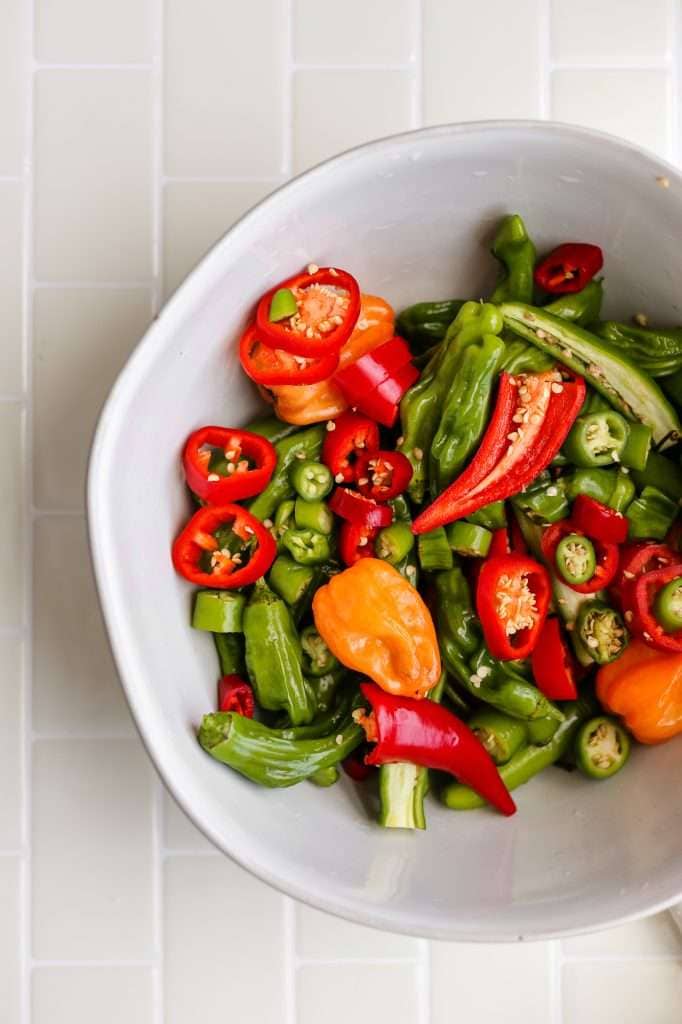
Fermented Shishito Peppers and Fermented Banana Peppers
At home, I’ve experimented with some fun pepper recipes. My favorite is a mix of banana peppers and jalapeños, but I’ve tried many kinds of peppers.
So You can use this recipe blog for just about any pepper type! I usually stay away from extremely hot peppers that are shades of orange and red, though, because I find that they taste a little soapy after fermentation.
Also, some peppers contain too much capsaicin, so no beneficial fermentation microbes can grow when fermenting those. I’m talking about peppers above 500,000 Scoville units (Trinidad Scorpion, Komodo Dragon, Carolina Reaper, Ghost Pepper, Naga Viper, etc.). I wouldn’t be surprised if there aren’t any bacteria on the surface of a Carolina Reaper pepper, for instance. At such a high concentration, capsaicin is bactericidal.
If you want to ferment extremely hot peppers, mix them in with more mild peppers and maybe some raw cabbage leaves to help initiate the fermentation process.
I suggest trying:
- Whole Shishito Peppers
- Serrano Peppers
- Poblano Peppers
- Jalapeños
- Banana Peppers
- Anaheim Peppers
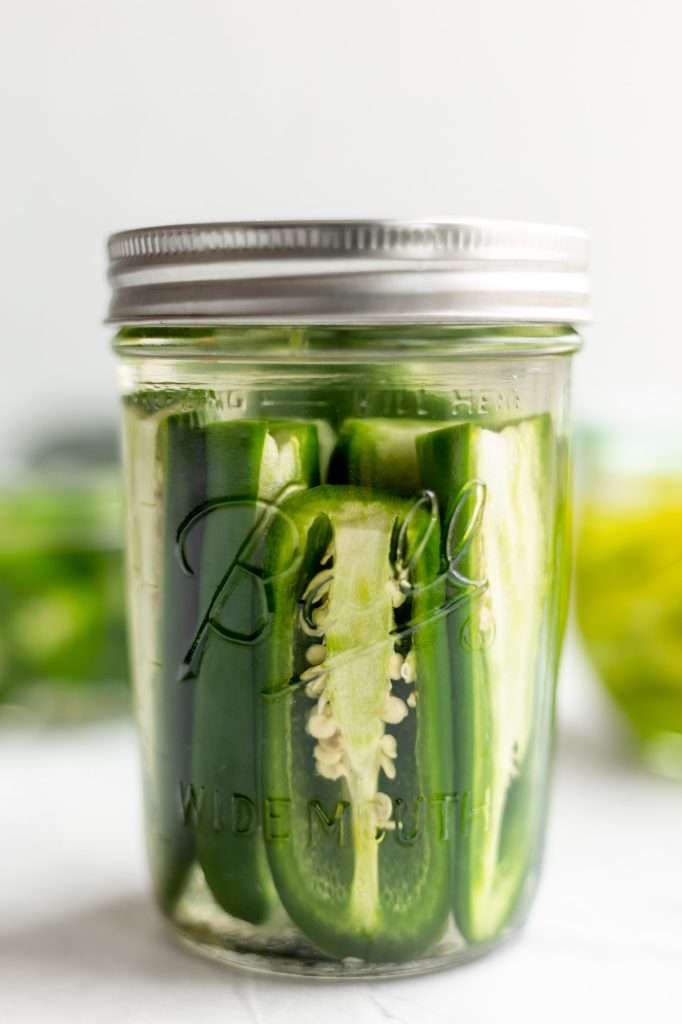
How to Make the Best Fermented Peppers
When it comes to fermentation times, the longer the peppers ferment the more the flavor develops. I love peppers that have been fermented for about five weeks. After five weeks they’re perfectly tart and preserved.
I have experimented with fermentation times though! I once fermented peppers for a YEAR and wow.
The wait was long, but the flavor was so unique and good! When fermenting for this long, it’s important to make sure the pH stays low the entire time. Also, when fermenting for extended periods of time, the beneficial bacteria can die off.
When fermenting peppers it’s better to use a slightly higher salt concentration than normal, about 3.5% of the total weight in salt is a good place to start. I like peppers fermented anywhere between 3% and 6% total salt concentration. (Read more about salt concentration here).
If you’re curious about the gut health benefits of fermented vegetables, including fermented peppers, you can read more here.

Mastering Pepper Fermentation
If you’re going to master fermentation, you’ll need to use weight measurements for your fermentation ingredients. That means you need a kitchen scale.
In order to select for the best probiotic bacteria (the ones that are actually beneficial) in your ferments, you must weigh salt to create a specific salt concentration. Weighing salt is the only way to create a salt concentration that will select for only probiotic microbes to thrive. You can read more about why you must weigh your salt here.

Supplies You Need for Pepper Fermentation
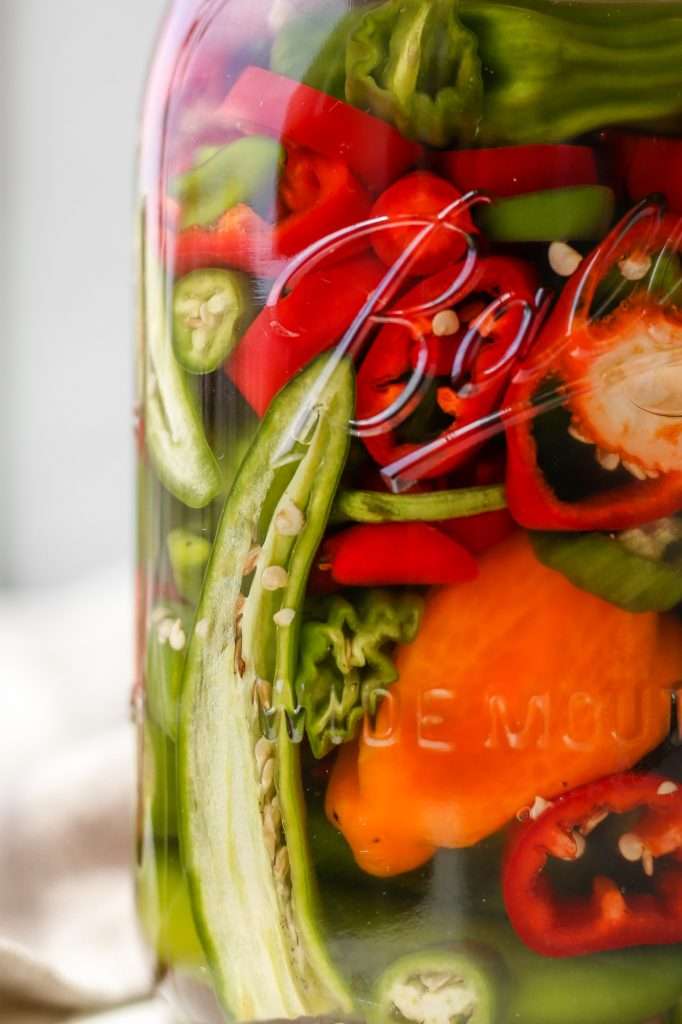
How to Ferment Peppers
During the first few days of fermentation: carbon dioxide and bubbles will be produced. Sometimes jars will become very full of liquid, and this liquid can seep out. It’s important to “burp” the jar during the bubbly stage.
- If using a standard mason jar lid: remove the lid and tamper everything back down using a gloved hand, tamper, or spoon. Make sure everything is still submerged below the brine, and re-secure the lid.
- You may notice pepper seeds floating. You can scoop them out with a clean spoon.
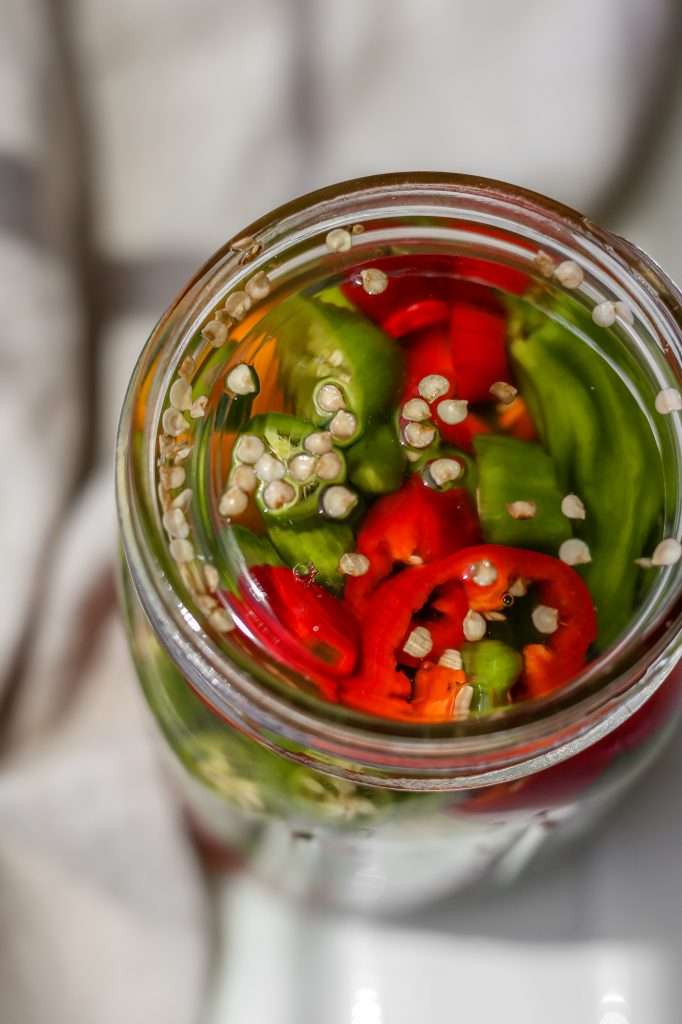
Always Trust your sense of smell: Fermented peppers should smell pleasantly sour and spicy. Never eat anything that smells repulsive.
Never eat anything that had mold growing on it: By following directions, you should not encounter this problem. Note that most vine-growing vegetables that are wild fermented will have something called pellicle growth. This is normal for “vine-growing” vegetables as long as they do not look furry, pink, blue, black, green, or magenta.
A safe pellicle is normally opaque, off-white, and crinkly. If you have surface growth like this, it’s a harmless mixed colony of wild yeasts. It’s not “mold”…you can skim it off the top and still eat your peppers. See the two pictures below as a reference for what a normal pellicle looks like.

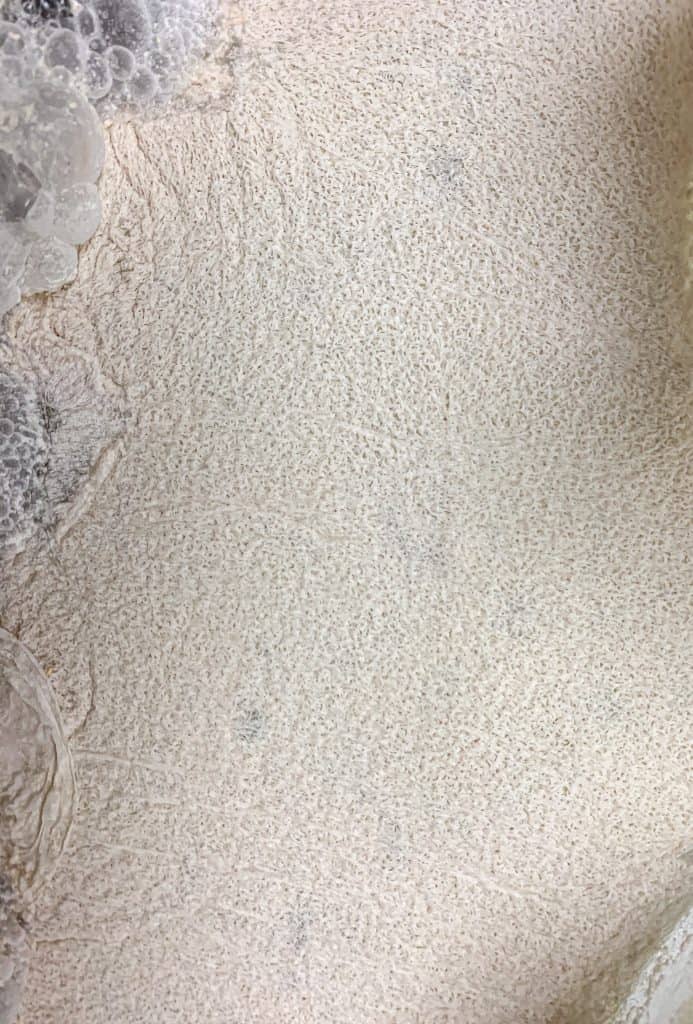
How to Avoid a Pellicle in Fermented Peppers
For this recipe, I used about 3.4% total (w/w) salt concentration. I’m usually able to avoid pellicle growth completely by increasing the salt concentration of the pepper fermentation.
Peppers can be fermented with up to a 10% total salt concentration, but I think that’s too high. I’ve tried a few peppers fermented at 6% and I never had pellicle growth with a total salt concentration of 6%. The yeasts simply do not tolerate such high salt concentrations.
This, of course, is a much saltier pepper ferment. However, the peppers come out more sour and this is perfect for hot sauce!
Click here to learn how to make hot sauce with fermented peppers.
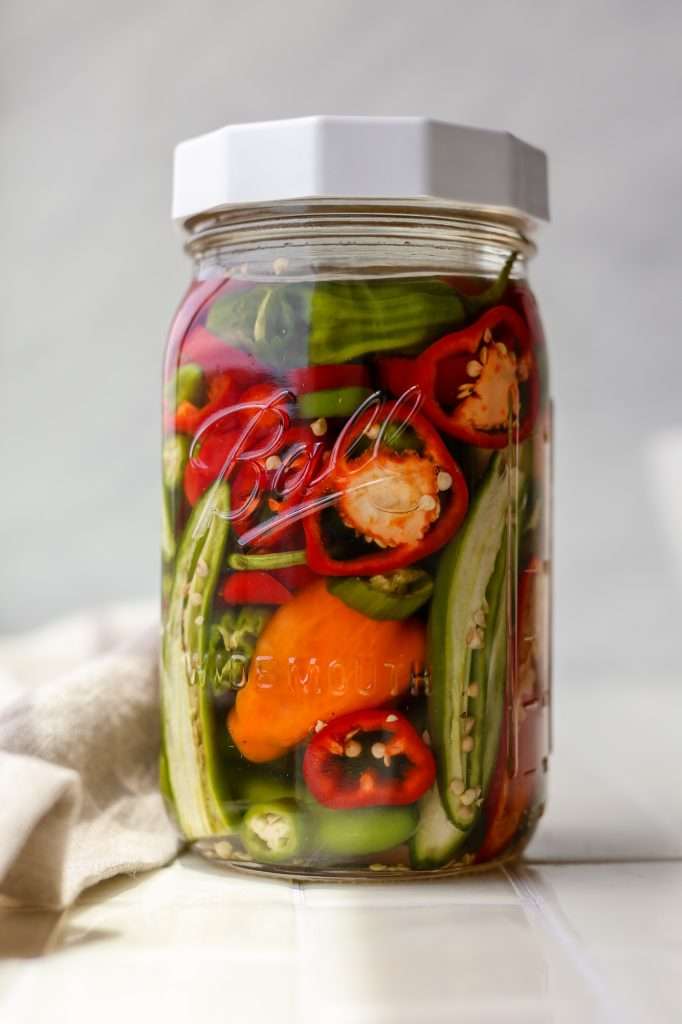
What Temperature Should You Store Fermented Peppers?
Keep your fermenting peppers at a temperature between 70-80 degrees F. Keep out of direct sunlight. After fermentation you should keep fermented peppers in the fridge.
How Long Should I Ferment Peppers for?
After 4-5 weeks, remove the fermentation weight and small and taste test. Your fermented peppers should smell peppery and pleasantly sour. They should taste start, savory, and spicy.
Do I Need to Refrigerate My Wild Fermented Peppers?
Taste test at four weeks: If you prefer the peppers to be more tart and sour, let them ferment for one to two more weeks. After fermenting for 4-5 weeks, place a regular mason jar lid on the jar and refrigerate. Consume within 6 months for full probiotic benefits.
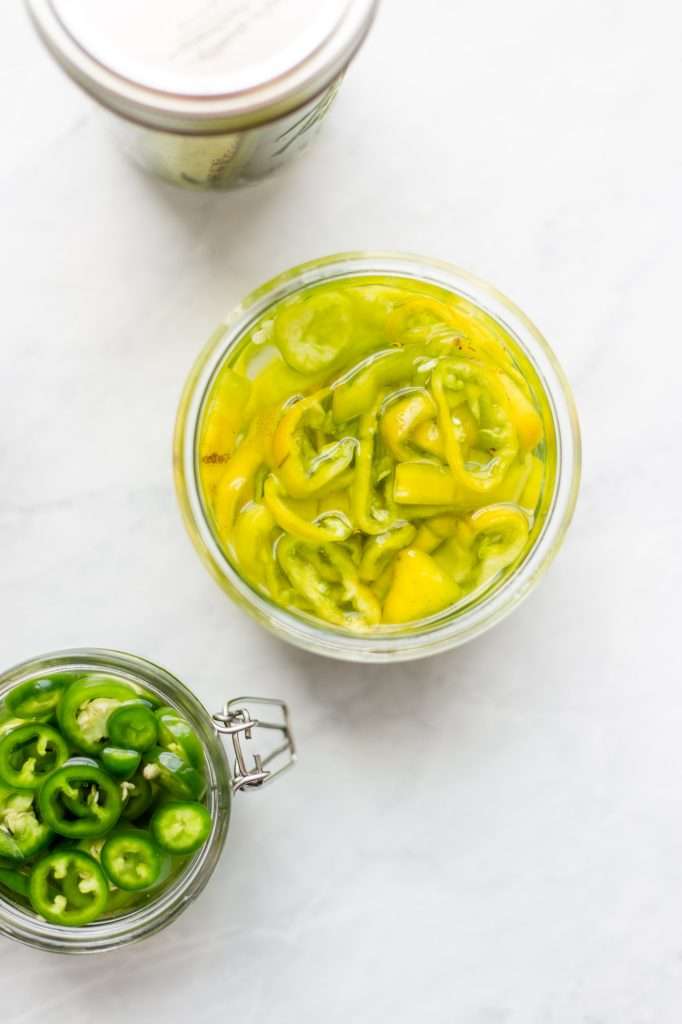
Wild Lacto-Fermented Peppers: Fermentation Timeline
We tracked our peppers throughout the fermentation process. By checking the progress of microbial stages under the microscope we have provided you with this handy timeline! If you follow our recipe and directions, your timeline of pepper fermentation should approximately match ours!
24 – 72 hours: All contents in the jar should be submerged beneath the brine. At this time there are still Gram negative bacteria and possible pathogens present.
72 hours – 9 days: After 72 hours you should start to see lots of bubbles being produced. This is the stage in which you will burp the jar (open the lid and make sure everything is submerged below the brine). This is when the ferment enters stage two of vegetable fermentation. Leuconostoc bacteria begin to thrive and produce a lot of carbon dioxide. Gram negative organisms die off. You may notice an acidic smell and color changes during this time.
9 – 14 days: The bubbles in the brine will decrease, as the ferment leaves stage two and enters stage three. The peppers will become cloudy and start to develop a pleasant sour smell. They will also start to change color from vibrant to more muted colors. Lactobacillus species are most abundant during this time period.
14 – 28 days: Lactobacillus make up the majority or all of the microbial population. They produce copious amounts of lactic acid and make the ferment smell even more pleasantly sour. This is the time in which the vegetable mixture becomes preserved.
30 days: Wait for the peppers to smell and taste as you like, and refrigerate when you find the smell and taste most pleasant! We like ours best when we refrigerate at about five weeks, but they are also good at around 30 days. The longer the peppers ferment, the more the flavors develop.
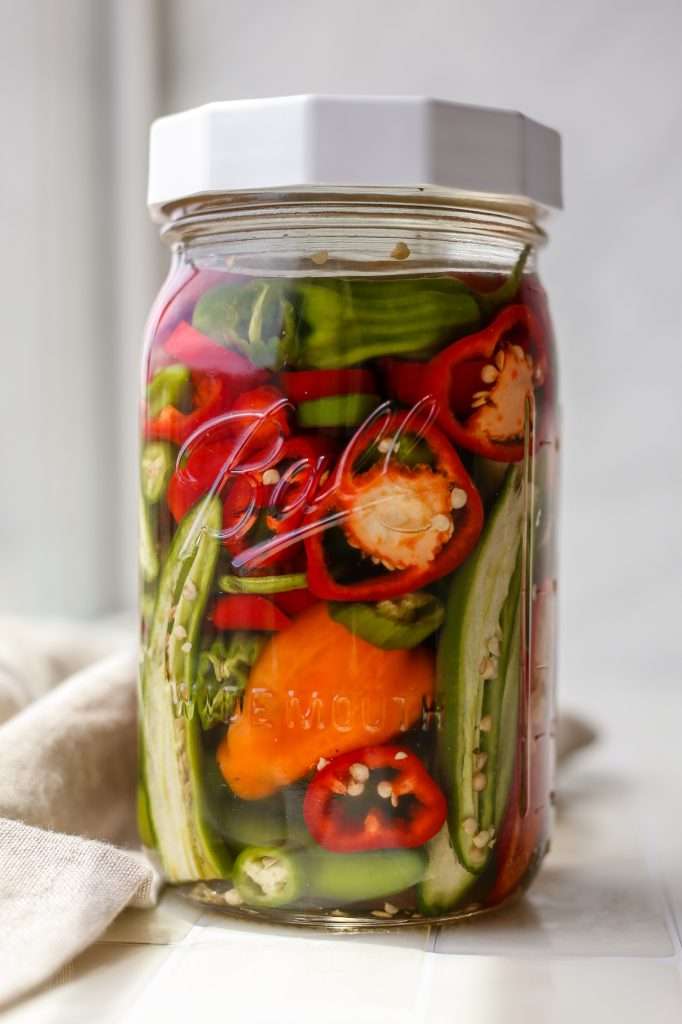

The Best Fermented Peppers
How do you make fermented peppers? What is the best salt ratio for fermenting peppers? how long to ferment peppers? With our Easy Pepper Fermentation Recipe you’ll have the best fermented peppers in just 5 weeks! Learn how to ferment any type of pepper at home.
- Prep: 15 minutes
- Total Time: 672 hours 15 minutes
Ingredients
- 330 grams Peppers
- 26 Grams sea salt
- 400 grams water
Instructions
- This recipe at 1x works best with a 32-ounce jar. Please use peppers below 500,000 Scoville units. Anything higher may not ferment well.
- Wash your fermentation equipment, including the jar, weight, and lid.
- Wash your peppers and chop to your desired consistency. You can chop into pepper rings, slices or minced.
- Place your kitchen scale on the counter. Turn it on and set it to weigh in grams.
- Place a mixing bowl on your kitchen scale and tare/zero the scale.
- Add your peppers into the bowl, measuring out the designated amount.
- Remove the bowl from your scale and set it aside. Place your empty, clean mason jar on the scale, and tare/zero the scale. Make sure your scale is still set to grams, and add the designated amount of filtered water to your mason jar.
- Add the peppers from your bowl, into the mason jar with water.
- Place a small bowl on your scale and tare/zero the scale. Weigh out the sea salt. Then add the salt to the jar of peppers and water.
- Place your standard mason jar lid on the jar, and secure it. Shake the jar for 2 minutes.
- Remove the standard mason jar lid. Place your fermentation weight in the jar making sure to submerge all of the pepper pieces and weight fully in the liquid.
- Secure the jar lid to the mason jar.
- Ferment for 4 to 5 weeks at room temperature, then refrigerate.
Notes
- Peppers above 500,000 Scoville units contain an extremely high concentration of capsaicin. At those levels, capsaicin is bactericidal and can prevent natural fermentation.
- Taring/zeroing the scale with a container on it subtracts the weight of the container, allowing you to weigh only what is added to the container. After taring/zeroing the scale, the scale should read 0.0 with the container on it.
- Peppers sold in a bag are triple-washed and lack essential microbes for fermentation. If using bagged peppers, I highly suggest adding two fresh cabbage leaves to this recipe as a “starter” for fermentation. You can eat the cabbage leaves after or compost them.
- During the first few days of fermentation, carbon dioxide is produced, and you must burp the jar.
- Yes, you can turn these into hot sauce after they’re fermented. Just strain the brine into a separate jar/bowl, throw the fermented peppers in a blender. Blend on high and add a bit of the strained brine into the blender little by little until it’s the consistency you want. Store sauce in an airtight container and keep refrigerated.


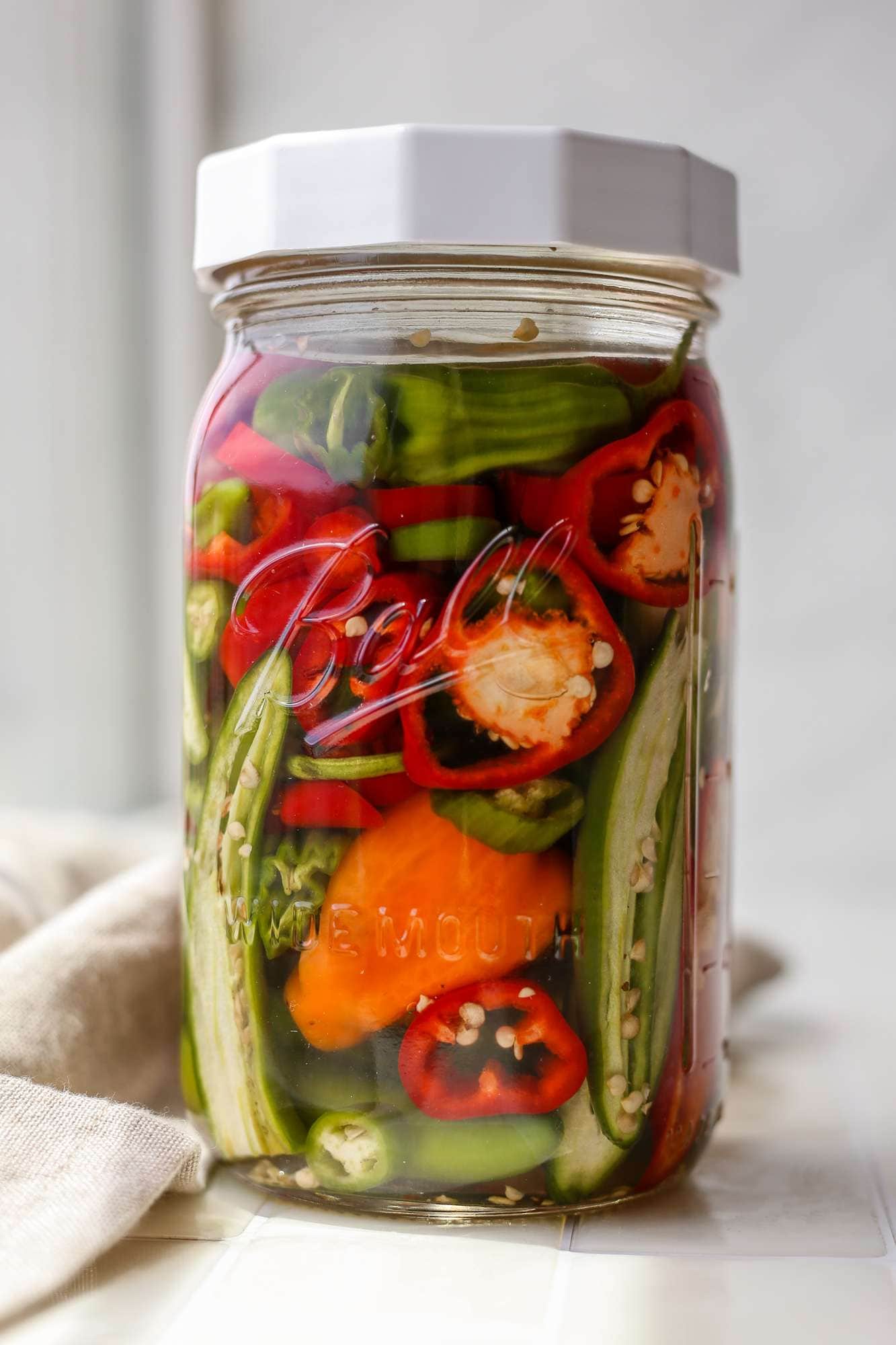

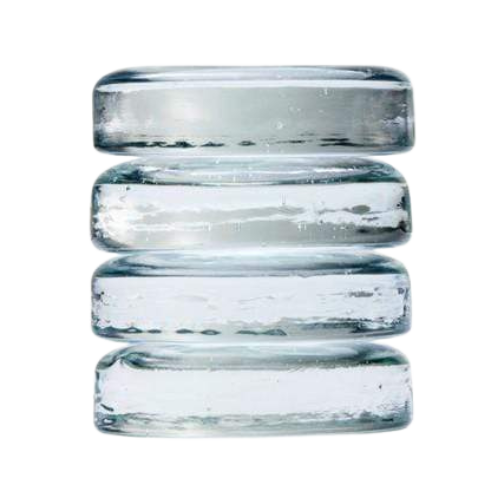

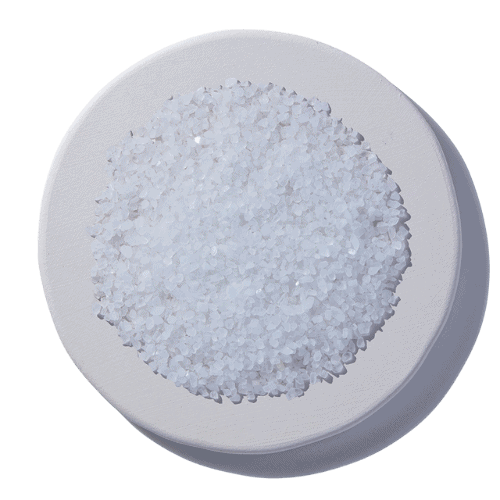
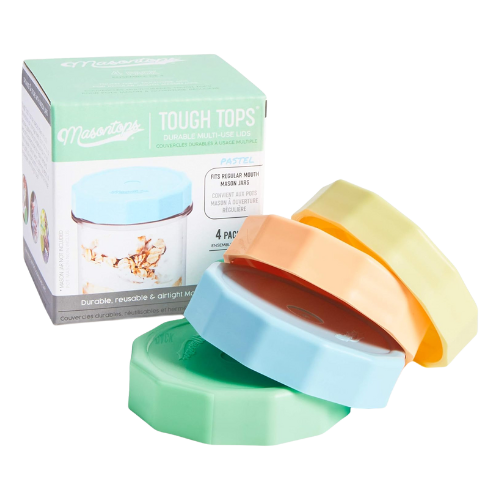
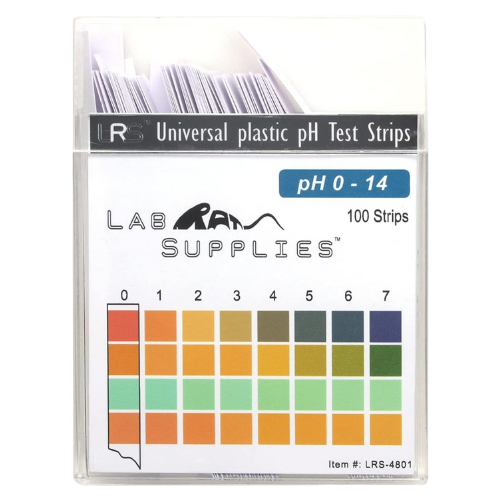












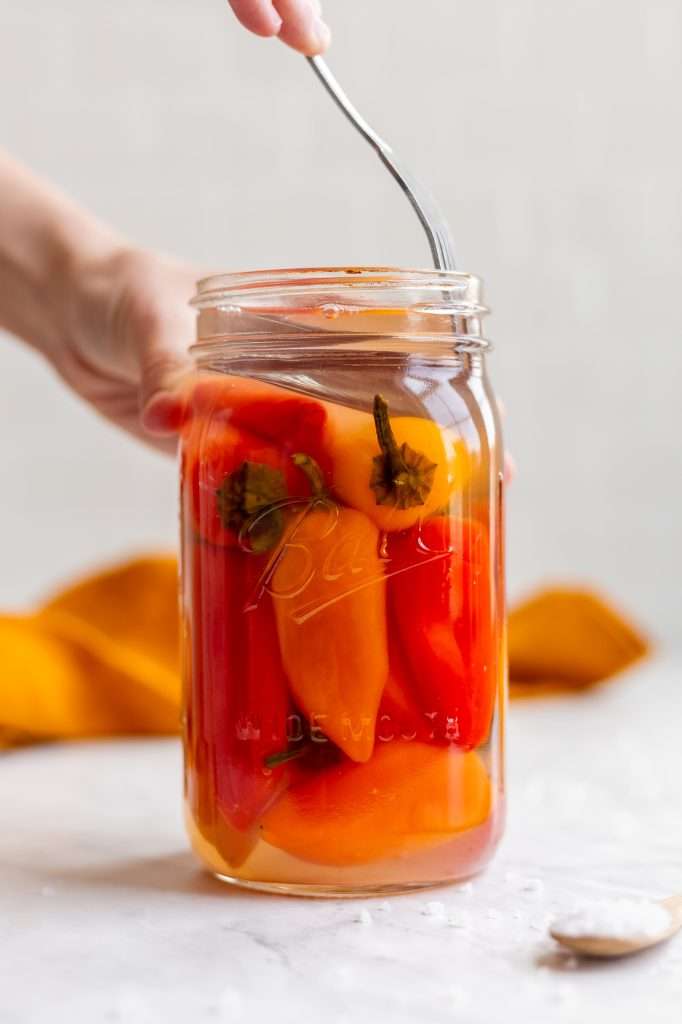
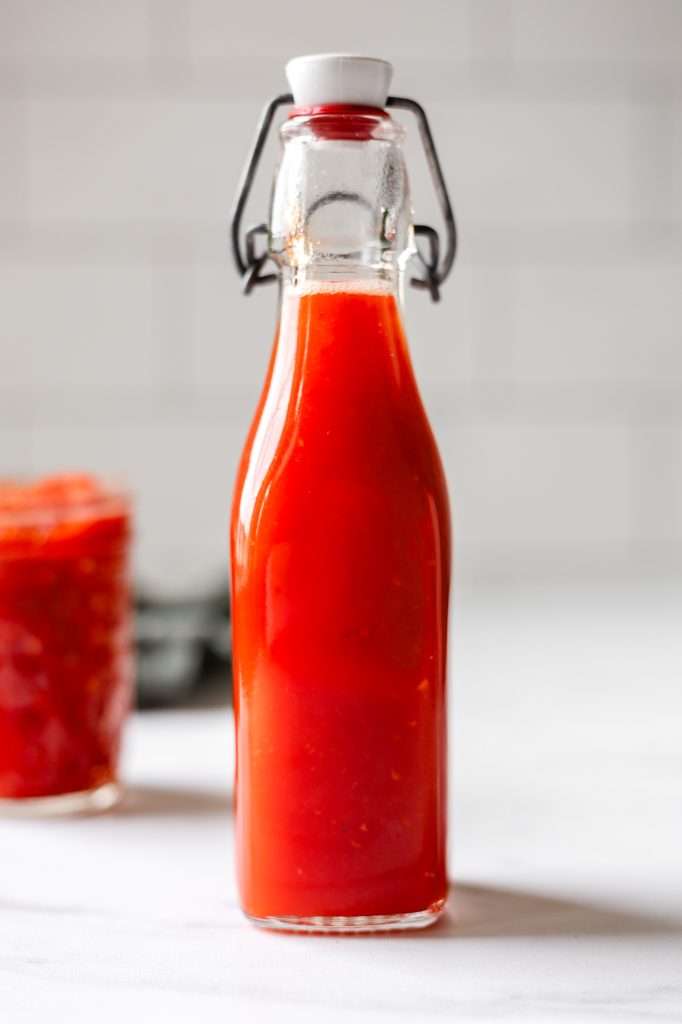
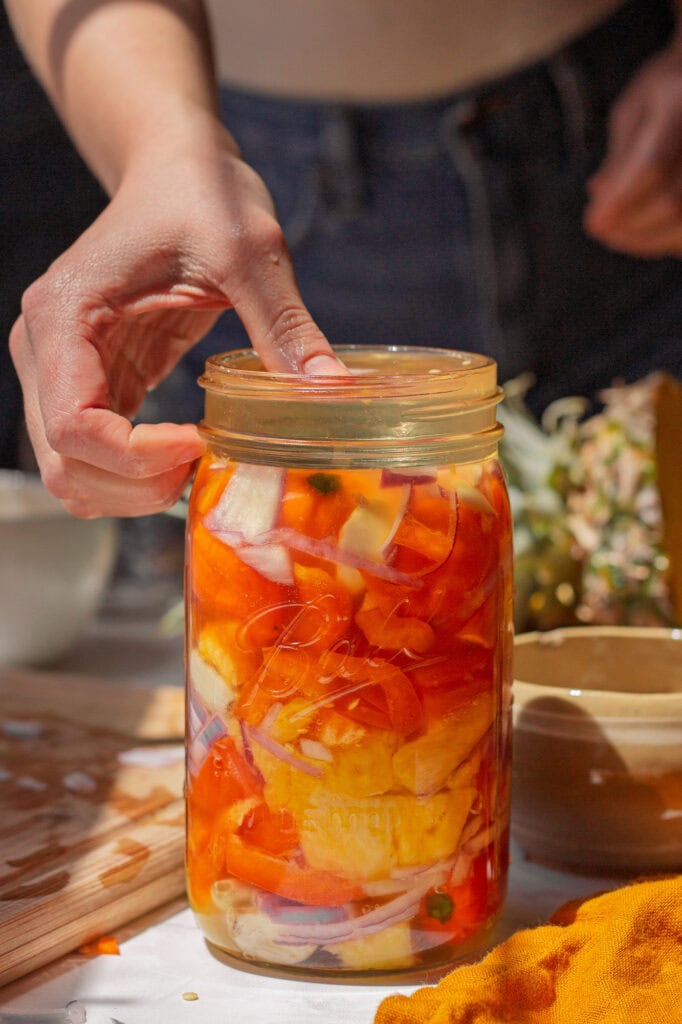

Yes, like the ingredients list said, 14g of salt…
but it seems that the instructional html copy was typed wrong in the recipe code. I’ve corrected it to say 14. Thanks for pointing it out!
Hello, I’m confused and hope someone can advise me. In the ingredients list and instructions or says 21g of salt for 400g of water, so that is what I did. Then I read the comments and see that it should have been 14g of salt instead. I just put up about 30 peppers this way yesterday. Should I dump some of the water and add fresh water? I don’t want them to be ruined.
The comments are old, before the recipe was updated for a larger quantity of peppers. With 21 grams of salt, 400 grams water and 200 grams peppers, you have about a 3.5% total salt concentration, perfect for pepper fermentation. If you read the body of the blog post, fermented peppers are great anywhere between 3% and 6% total salt.
To safely achieve your desired salt/brine ratio you should always weigh the entire contents of your ferment (fruit & water) not including the weight of your container. Then multiply that by your desired salt/brine concentration (3.5% or 0.035) to get the correct amount of salt by weight. ex. 800g peppers & 200g water = 1,000g x 0.035 = 35g salt.
I’ve just tried fermenting banana peppers and Serrano peppers for the first time, and I have a couple of questions. I’ve fermented both for 4 weeks.
The banana peppers are super salty and don’t taste tangy at all, but there was a lot more brine than peppers in the jar. I thought the jar was more full than it was but once I put the weight in the jar it pushed the peppers down to fill about 1/3 of the jar and the brine was at the top. I had a normal plastic lid on the jar.
For the Serrano peppers, I used one of the silicone fermenting tops and secured it with a metal ring. I haven’t tasted them yet because when I took the silicone lid off, it had what looked like black mold around the edge. It seemed to just be where the glass rim of the jar touched the silicone lid. I washed everything before I used it as well. Should I throw out the Serrano peppers? It doesn’t look like the black stuff got inside the jar, but not sure I want to take any chances. I wanted to make sure you agree or not agree I should dump them before I do.
I appreciate everything you put on your blog to help us!!
Never eat anything with mold growing on it—safety first! I personally don’t recommend silicone lids because I’ve found they can cause issues like mold.
As for your fermented peppers not tasting sour enough, it’s important to remember that fermented peppers won’t have the same tang as pickled peppers. Fermentation produces lactic acid, which has a milder, subtler sourness compared to the sharpness of acetic acid in vinegar pickling. If you’d like a stronger flavor, make sure everything stays fully submerged under the brine, keep the lid clean, and let them ferment at room temperature a bit longer. Another option is to add a bit of raw apple cider vinegar to the jar when you refrigerate.
FIRST: Great site! Thank you! Regarding the Silicon “Pickle Pipe” lids, I’ve read many accounts of problems but never once experienced any. My 2x daily routine for anything I’m fermenting, REGARDLESS of the type of top/lid, is to tilt the jar about 45 degrees and rotate it once or twice to assure both the lid and any floaters {always a few no matter what I do} are moistened by the brine. Again, never had a failure. Seems the brine is protecting the lid from bad beasties.
I think that’s the thing about the pickle pipe lids too… most people see them as an excuse to neglect the jar while it’s fermenting. They don’t check things at all or tend to it because its “self burping” so then things get moldy.
Before this new blog/website you guys had a recipe up that recommended a 4% brine. Why 3.5% now?
I’m not completely sure, but I think I remember the last recipe saying just making a 4% brine and adding it to the peppers. Basically not taking the pepper weight into account. Am I wrong?? And if not what changed
We transferred all of our blogs to our newly designed website as-is. So we havent changed our pepper recipe. All of our fermented vegetable recipes account for the weight of water and vegetables to calculate a total salt concentration. You can safely make fermented peppers with any total salt concentration between 3% and 6%. We get the best results with 3.5%… 4% is fine too.
Hey Kaitlynn!
Do you ever find that the peppers form a pellicle (similar to how you say the cucumbers do) with this method? I tried a batch awhile back and it formed what looked like one on the top and they still smelled okay, but I was skeptical so discarded it. But after reading the pickle post, the pellicle you mention there looks pretty much just like the one that formed with my peppers so I was just wondering if that’s something you have run into as well
Thanks!
Yes! Fermented peppers oftentimes form a pellicle just like the cucumbers. It’s very common amongst all fermented vine-growing vegetables, since their microbiomes are similar. I was finally able to get a good picture of a pellicle when I was writing the pickle blog, but I’ll add those pelicille pictures to this pepper blog too.
You said, “I usually stay away from hot peppers that are shades of orange though, because after fermentation they tend to taste like soap.”
I’ve been fermenting Cheyenne Peppers which are a bright orange colored hybrid chili pepper of about 30,000- 50,000 Scovilles (ours are usually on the spicier side) and taste lovely once lacto-fermented. They’re impossible for me to eat raw but once lacto-fermented some of the Capsaicin is killed off and they’re perfectly sour spicy and zingy. Go great in omelets, pizzas, salads, or how I eat them straight from the jar.
I’m just curious what exact peppers you’re saying taste “soapy”, but it certainly isn’t the case for these peppers.
Hey there,
yes, I phrased it the way I did because this is my personal experience using the recipes I develop. I’ve never tried to ferment Cheyenne peppers, so I’ll have to experiment with that! Thanks for sharing your experience 🙂
I’ve experienced the soapy end flavor when fermenting yellow-orange Caribe peppers and habaneros using this recipe, specifically. I’ve had success fermenting both using a much higher salt concentration of 6% and an 8-week fermentation time.
Did you mean Cayenne peppers?
They may have, I have fermented cayenne peppers, but Cheyenne peppers are a type of pepper as well. They are hybrid cayenne peppers.
Hi Gurus,
I’m a new reader of your blog. Thank you for sharing your knowledge with us. I’ve just started on my vegetable fermentation journey.
The two times I’ve fermented Serrano peppers, I noticed a white sediment at the bottom of the jar. I’ve been using it hoping it’s safe since it’s still submerged in brine. What could this be? Have you seen anything like this?
Thank you 😊
Lakshmi
Hey there!
Cloudiness and sediment at the bottom of the jar is completely normal! It’s simply dead microorganisms and fermentation byproducts from the first two stages of fermentation.
Hello Kaitlynn,
Officially addicted to your blog. I also ferment Taiwan chilis. (90 pesos, $1.80 a kilo here) I usually cut the tops off, (with gloves on)should I leave leave them whole and just poke a hole in them? I make a sauce with them and add roasted red peppers, cider vinegar and salt then blend. I will now let them ferment for 5-8 weeks and try a 4 and 6% salinity. I make mine by the gallon jar, sharing is caring. Thanks again for your recipes. I really appreciate them.
Justin
Hi, Kaitlynn,
Would a fermentation crock yield the same results, potentially?
Thank you 🙂
Trisch
Yes! a fermentation crock will work well. You still need to keep everything submerged with a fermentation weight, even with the water seal crock lid.
This is so helpful! I have not fermented peppers before so I’m excited to try. Your instructions are clear and concise! I do have two questions. 1. Do you think shoshito peppers would ferment well with their thin skins? And 2. In your last paragraph you say, “ We like ours best when we refrigerate at about five, but they are also good at around 30 days. ”. Can you please clarify? Do you refrigerate at 5 days?
Thanks!
Shishito peppers work great with this recipe! When I originally published this recipe I used shishito peppers, and they were delicious. Just don’t use shishito peppers that come in a bag. Those are usually triple washed and do not ferment well.
That last sentence was supposed to say five weeks, just like the timeline above that paragraph. I fixed it, thank you for pointing it out.
Hello! I am new to the fermenting process and can not wait to try your recipe! I was curious, is it ok to add seasonings such as garlic to this recipe to add other flavors to it? Again, I am new to the process but I was just wondering.
Well, welcome! I’m glad you found your way to our safe and healthy fermentation recipes.
Yes! you can add seasonings like a bit of garlic or onion, just keep all the other ingredients and quantities consistent as written in the recipe.
Can a pellicle develop on the vegetables themselves and not just on the surface of the brine? Is this still safe?
Yes, it’s possible if the vegetables are floating above the brine. Everything within the brine will get cloudy, but there shouldn’t be anything growing on vegetables if they are submerged below the brine.
Hi there, should I de-stem the whole shishitos or just cram em in there with a bit of the stem attached?
Thanks so much!!!
either way is fine! I left the stems on when I fermented shishitos
I have read that one should use cheese cloth or a fermenting lid rather than a mason jar lid. It was said there was danger of the jar exploding during the fermentation process. What has your experience been
You should never use cheesecloth for vegetable fermentation, the lid should always be solid and fully closing. I don’t know who “it was said” by… but if you read this blog post and the recipe notes, I indicate three times that you should burp the jar while it is in the bubbly stage. I’ve never had a jar of fermented vegetables explode with a standard mason jar lid.
Been fermengting for years. Just made these. Everything was cut from small fresh peppers from my plants into small rings. There is not enough water in this recipe. Using a 32 oz jar does give enough liquid, and the rings and peppers have to be.severely crushed down, pressing to make barely enough to hardly cover the weight. I weighed everything out to the gram and make tons of fermented foods. Also, despite the recipe calling for 3.5% brine, this recipe is 6.5%. I have even double verifying a brine calculator. 26 grams of salt to 400 grams water is 6.5. is a step missing where you top up with water after adding everything?
I’ve tested this recipe too many times to count and there is enough water in this recipe. There should be more than enough room to properly pack it all into the suggested 32 ounce jar.
And no, my fermented pepper recipe does not call for a “brine percentage”
My recipes call for total salt concentration, which is far more accurate and safe. Fresh peppers are approximately 92% water, so we also account for the water inside vegetables when calculating salt concentration, because osmosis is… a thing.
Thank you so much for including the information on the change in bacteria based on days fermenting and acid content. I was beginning to get worried as my tomato/pepper ferment was very sour smelling. I am on day 4 and will keep burping! It smells a little good and a lot sour. But I expect that it will soon change to smelling very good and a little sour. I appreciate you adding the science in!!!! So very helpful!
BTW, I used Thai chilis (red) and Sungold Cherry Tomatoes (bright orange and sweet) that I have grown in the garden. It is such a lovely bright orange shade right now! I wish that it would stay that bright. But if I understand correctly it will be a bit more dull in color when it is finished. Either way, I am so excited and glad that I have come across your blog. It is very helpful to be able to reference something so well written. Thank you and please keep it coming!
Most excellent site! I have wanted to try preservation by fermentation for quite a while… I am finally starting with this pepper recipe today. It is already twigging my taste buds!
Glad you found us here! Enjoy the recipe! 🙂
Hi, I’m new here as well. Quick question. Is the weight absolutely necessary to keep the peppers submerged? Would filling the water line to the near top keep the peppers submerged since there wouldn’t really be space for them not to be submerged? And if the weight is necessary, is there anything I can use in place of? Instead of buying a weight.
Hey there, and welcome to the fun world of fermenting!
Yes, you need to keep them submerged, it’s very important. But here is a fun trick if you don’t have the means to get a fermentation weight:
Fill the jar as much as possible and secure a solid mason jar lid. Place the jar in a glass dish to prevent messes. Every morning gently flip it upside down and leave it to stand on the lid for about 12 hours. Before bed, gently flid it back to stand upright. In the morning upside down again, at night right side up.
This will keep any of the pepper pieces from being out of the brine for too long.
You’ll still need to burp the jar to release the gas in the bubbly phase. If you are using a metal mason jar lid, you can take the lid off for a moment and rinse it off before replacing it to keep it from rusting.
love this very detailed, but I do have a question as your article says do not use red peppers because they will taste soapy? so no cayennes or red hots? I have so many cayennes and I would love to do this with them
I am a big fan of Kosher salt but I noticed you did not list that in your list of salts to use.
I ha
you can totally use cayenne peppers! They work great. I just stay away from extremely hot peppers that are shades of red/orange—ones that are above 300,000ish scovilles.
Hi there,
I really appreciate the science you’ve presented in this blog! I just started some 2 days ago and I check them about 5 times per day, LOL!
I have a question about pellicle. Since it’s a yeast, is it possible to use it to make bread?
I think it would definitely be possible! I’m unsure what kind of flavor would develop, but it would be a fun baking experiment. Let me know if you try it!
Hi Kaitlynn,
I’ve gotten everything I need to ferment jalapeno peppers following your instructions, although I am a little confused on one aspect. Although you state clearly several times that any salt concentration between 3% and 6% will work for peppers, on this particular page your pepper fermenting instructions recommend 3.5% salt. Sounds great, I’m ready to go! But, then I notice on your “Complete Guide to Safely Using Salt in Vegetable Fermentation” page, you list 4.0% being best for peppers. Please clarify which concentration between 3% and 6% you think would be best for jalapenos. 3.5% or 4.0% ? Thanks, loads!
Also, if I may ask? What are the four types of salt in the fermenting mix that you used to sell on this site, that is no longer available? Thanks again! Love your work!
Any salt concentration between 3% and 6% works… so both 3.5% and 4.0% work well. I like them anywhere between 3% and 6%. It’s not a matter of clarification of which is best. As long as you stay in that range, it’s just a matter of flavor preference. If you want to use this exact recipe, just use the salt concentration I used here… 3.5%
It’s a blend of two flake sea salts, Himalayan salt, and sel gris.
Thanks so much for your reply. 3.5% it is then!
You are awesome!
Hi, I’m so glad our found your site 😀
Is it ok to use cabbage leaves to keep the veggies submerged? I don’t have enough weights and they are ridiculously expensive in Australia. Tia
of course! Cabbage leaves will work fine.
About a month ago I started a jar of peppers following about the mentioned proportions of salt and water. I used red bird, habanero and ghost peppers, as well as garlic from the grocery store. I’m concerned they haven’t really fermented. They dont look like they’ve changed as much as i expected. They smell okay and I tasted the liquid which is quite hot. I’m just uncertain if the fermentation has worked.
Is there anything I shouid do at this point to save this batch?
Hi there!
What do you mean by “about the mentioned proportions”? Did you measure your ingredients by weight? This is the only way to ensure consistently good results.
Did the liquid bubble and become cloudy?
I haven’t tried this recipe as it’s pretty similar to mine but I cannot seem to get peppers that are crispy, they always go soggy. Any advice? They’re always super firm when I start them.
Hi there! If your peppers always go soggy, it’s most likely because you are not using enough salt.
Hi, I am fermenting around 4kg of jalapeños in 4% brine in a 5L size crock. I added 5 cloves of fresh garlic. Is the addition of garlic likely to inhibit the drop in pH during the lactic acid formation stage of fermentation?
I am fermenting around 4kg of jalapeños in 4% brine in a 5L size crock. I added 5 cloves of fresh garlic. Is the addition of garlic likely to inhibit the drop in pH during the lactic acid formation stage of fermentation?
Sounds like a great batch of peppers! the addition of a few garlic cloves won’t inhibit or change anything.
I just took my 1st batch of Banana Peppers out of the crock and transferred them to a Mason Jar for storage. They have been fermenting about 6 weeks. They are crunchy and delicious! Your recipe is perfect! I was worried because when I transferred them to the mason jar and poured the liquid over them it was cloudy, but from what I read here on your blog it will settle back down. Thank you! Your blog is awesome!
I just transferred my 1st batch of Banana Peppers from the crock to a Mason Jar. They have been fermenting for about 6 weeks. They are crunchy and delicious! I was worried about the liquid being cloudy when I poured it in the jar, but after reading the comments here, I think it will be fine once it has settled down again.
Your comment about triple washed peppers from the grocery store makes me wonder…how much should I wash my homegrown peppers in order to keep the wild microorganisms at a good level? Excited to try this. We’ve had a bumper crop of jalapeños (green, red and yellow) and am trying to fine more ways to preserve them.
you just need to give them a light rise in cool water. “triple-washed” vegetables in bags from the store are washed with anti-microbial compounds, so just don’t use any soapy vegetable washes or anything like that.
Hello, thanks for all the information! Is it a bad idea to ferment different types of peppers together? Would that affect the outcome?
You can ferment a mix of peppers. Depending on the peppers it will just change the level of heat and flavor a bit. Green peppers are more herbaceous, I guess you could say, and reddish orange peppers are more earthy.
Hello Kaitlynn….I noticed Weck jars in the above photo. Did you do the original fermenting in those jars or transfer the peppers to the Weck jars after fermenting?
If you can do the fermenting in the Weck jars, how should we go about doing that as the fermented weights do not account for the wide girth of the wide mouth Weck jar (solution tends to rise above the weights given the excess space around the weight when placed in the Weck jar)? Does this affect the process?
Thanks for the help…. Shannon
I’ve fermented in both Weck jars and mason jars. A wide mouth glass fermentation weight fits perfectly in the ~16 ounce tulip weck jar and the weck jars linked in this post. You can also use some cabbage leaves to tuck everything in before placing the weight in.
When using fermenting lids and springs do you still have to burp jars?
If the lid is solid sealed, it needs to be burped. I don’t ever use special “fermenting lids”.
Have you ever fermented ghost peppers like this?
I have not, mainly because I don’t find a need for things that hot. I like to stick around 30K to 50K Scoville units max.
Hi, I tried this recipe for fermenting shishito peppers. They are crisp but very bitter! What can I do different on my next batch?
Thank you
You can let them ferment longer. The flavor of fermented peppers usually gets better with time.
Hi, I’m looking forward to fermenting peppers. Do I need to de seed peppers or can I just slice into rings and ferment seeds and peppers together?
You can leave the seeds in or you can remove them. it’s up to you. Leaving the seeds in can sometimes cause a bitter flavor and also makes the pepper hotter.
I have some peppers, mostly green, red and yellow jalapeños, that have been fermenting for 5-6 weeks now. I wanted to make a hot sauce that can keep for a long time, as I experimented with varying amounts of some REEEEAAAALLLY hot peppers (Death Spirals) and don’t see us plowing through it very quickly. If I add fresh onion and peppers, is that going to shorten the “shelf life”? I know the ACV won’t but about how much would you suggest of each? I fermented in quart jars, and one pint with the highest concentration of the death spirals Any other suggestion for turning these peppers into hot sauce?
You could pickle the fresh onion and peppers and then combine the pickled mix with the fermented mix to make sure the shelf life is longer.
Hi Kaitlynn! After 5 weeks of fermentation, would the peppers be able to be preserved by water-bath canning method? Is the ph low enough to prevent botulism spores from “waking up”?
Yes you are able to can the peppers after they ferment, but you have to bring them to a boil, hot pack them into hot jars, then water bath can. You can test the pH to be sure, but they should be below pH 4 which is safe from botulism.
Thank you for your quick response! It’s just what I needed to know. I’ve dug deep in the “hard drive” of my old chemistry knowledge , and have figured out how to use citric acid to get a 3-4 % solution that has ph 2-3. So if I need to , I can adjust ph with citric acid. I have a ph meter to test with. Thank you again for your help. Constance
Thank you for your earlier responses. We are loving the fermented peppers and this weekend I will turn some of them into hot sauce. We’ve had a few weeks of the crud here, so that just means the peppers got more time fermenting. Love the flexibility fermenting gave us!
Turned out perfect!
I guess I didn’t ferment enough peppers this summer. Is it possible to ferment frozen peppers? I have a bunch of sliced jalapeños I could use. If not, what if I used fresh jalapeños from the store and used one of our frozen home grown crazy hot peppers in the mix? Thanks for any guidance!
Can you Add Brine From Previous Ferment To Get New One Started faster
If I don’t have weights, can I just purree the pre-salt brine
No, you should follow the recipe as it’s written. If you don’t things can easily go wrong.
Can you process the peppers after being fermented?
I like to blend them up into hot sauce! But that’s the only “processing” I’ve done with my fermented peppers
Help please. I have done everything per the instructions but have run into a snag. I am unable to cover 330 grams of peppers and a weight with 400 grams of water in a 32 oz jar. It’s not even close. Is something off i.e. should there be less peppers or more water? I’m on hold until I get some clarification. Also, I have already tried twice to submerge the peppers in water. Have I now rinsed the peppers too much for them to ferment properly?
Thank you.
are you using larger whole peppers, so they are taking up more space in the jar? Try slicing them. These measurements always work for me and I’ve been making this recipe for 5 years. It shouldn’t matter if you’ve rinsed them a few times.
Ok, slicing them smaller did the trick. I had cut them into spears. All of the peppers and weight are under the brine. I’ll let you know how they turn out. Thank you!
This entire ferment is shishito peppers. It is 13 days old and seems to have developed pellicle. I skim it daily and when I do it is surprisingly dry. The peppers have reduced to about half their original size and the brine is cloudy and smells like alcohol and is peppery. The smell is pleasant and not off putting. Does this seem to be progressing normally and should I continue to allow it to ferment? Thank you.
Since it’s only 13 days in, I think all of this sounds normal. Like in the timeline above the recipe, I suggest letting peppers ferment for 4-5 weeks at least. Sometimes longer to let the flavors develop more.
Thanks for this recipe, it looks and sounds delicious! Gonna try it with my garden grown peppers. One question remains for me: after the 30 days and putting the jar in the fridge, do I still need to keep the peppers submerged all the time until I finish eating the jar? Or are they ok from then on to swim normally in the water? T
Once it’s in the fridge you can remove the fermentation weight. You don’t need to keep it submerged in the fridge.
“I like to blend the higher salt fermented peppers with fresh onion, a few different types of fresh peppers, and apple cider vinegar for a perfect hot sauce!”
Do you have a recipe for your hot sauce somewhere? How much vinegar and fresh peppers do you add?
I don’t have a written recipe for it yet; I never make it the exact same way. I do teach students in my online course a loose hot sauce tutorial. I am developing a fermented sriracha recipe that will be posted here on the blog soon though.
Do you know if I can move fermentation lids to a new jar and loosely put lids on once it’s at the stage of decreases bubbles. Currently at day 16 and want to start a new batch.
Yeah, you can take the lids off, switch lids etc. I do it all the time. As long as everything is still submerged with a fermentation weight taking the lid off is no big deal.
Hello, I have been fermenting shishito peppers for five weeks. Around the three week mark the ferment developed pellicle which I have removed on a daily basis. The peppers have a lot of sediment on them, so much so that it looks like snow. The peppers are layered and each layer has sediment in between. Also, the brine has a fruity, yeasty aroma. The PH is 4 or below. My question is while this meets the criteria of being edible it is not vey appetizing and I am concerned about the large amount of sediment; would you recommend composting this batch and starting over? On another note I have fermented two of your other recipes and both turned out great. Thank you.
Sediment within the brine is natural and normal. It’s just spent bacteria. I do not think that you need to discard the batch. I recommend scooping off the pellicle, pouring off a little brine, topping it off with a bit of raw apple cider vinegar, and placing them in the fridge to age for a few weeks.
Hi Kaitlyn, Thanks for the science-based information on how to ferment any pepper. I’m about to follow this recipe. One question I have – I may have missed it, but do you provide any guidelines on how much water to use? Luckily the batch I’m working on right now is very close in weight to the one you used in this recipe, so I’m just going to follow it. But I plan to ferment some smaller batches of other varieties of pepper, and can’t figure out how to determine how much water to use for those projects. Many thanks!
Hello!
You can simply scale this recipe down by dividing it. There isn’t a set formula or ratio of water when I develop recipes. The important part is having the correct salt concentration, which is a % of the total weight of water and vegetables.
I mostly ferment what ever is ripe in the garden, usually a mixed jar of veggies including peppers. In the past I have used 3.5% salt, because the peppers take the higher percent. Do you think that is necessary? If I do other veggies without the peppers I can cut it back to 2%. Just wondering what an expert would advise. Thank you!!
Well, it’s been 5 weeks since I packed a bunch of jalapeño slices in salt brine and set them in a dark cabinet. According to the instructions, they should be done.
Taste test: I should have deseeded them! Definitely still plenty of kick. Salty and crunchy but mostly just like a jalapeño slice.
I don’t know that they taste that sour/fermented to me though. They don’t smell bad, just not like I was expecting. I was expecting something like creme fraische or kraut.
If they don’t taste sour enough yet, then let them ferment longer. I’ve let peppers ferment for 6 months before, to achieve the flavor I wanted.
Okay so I did this and they are so salty I don’t know if I can eat them. Do you rinse them to store in refrigerator after fermenting?
Everyone experiences saltiness differently. These peppers aren’t any saltier than a brined olive . If you you personally think it’s too salty, you can remove half the brine, top it off with some vinegar and put it in the fridge. That will cut the saltiness and add a nice vinegar flavor.
Is it possible to can these peppers after fermentation? I know it kills the lacto bacteria but we have an excess of peppers and want long term storage. Wanted to know if it is safe to can then or if this is more of a “fridge pickle” recipe and unsafe for canning?
The pH is safe for canning, in theory… and it would all need to be cooked to a proper temperature, and I don’t know how that would change the texture. I’ve never tested it so I can’t tell you for sure if it’s safe or a good idea.
Designated amount of water??? I didn’t see it addressed until the directions. Which section did you cover it in?
The amount of water is listed with the peppers in the ingredients list. Right above the instructions
Love the simplicity of this!!! Can’t wait to try. Just wondering if you ever use Asian fermentation jars? I have one, but it is super hard to find recipes and I am worried that I may not do it right and stuff may go bad.
I only use the fermentation equipment listed in the blog, so just a mason jar, weight, and lid.
Ever use smoked salt, like maldon?
I haven’t, but I think it would be good.
Thank you for the step-by-step instructions and explanations! Thoughtfully and thoroughly written for beginners. The links to more info/ideas are well placed and helpful, too. I just started my peppers today and am excited to try them in 5ish weeks!
Thank you for leaving a review!
Hello, as a chemical engineer I love your blog and the detail! I am considering making a fermented version of southern chow chow that is typically pickled using vinegar and sugar. It contains green tomatoes, bell peppers, onion, and cabbage. Would you suggest a wild ferment for 3-4 weeks or a wild heirloom culture using a sauerkraut brine for 48 hours?
I would say wild ferment for 3-4 weeks! Sounds delicious!
Hi, I assembled the peppers a week or two ago and I noticed Pellicle mold is growing. I skimmed it off but it came back. I read in your post that it is still safe to eat, but I’m wondering how to help it not come back? Should I take it out and remake the brain or how can I help it from not growing?
Mold is not safe to eat. Mold and kahm yeast aren’t the same thing. Are you keeping your jars and lids clean and keeping everything submerged?
I have some beautiful Hungarian hot paprika peppers, the variety used to make Eros Pista, and I’m wondering if any of your pepper ferment recipes would work. It’s a thick and salty ground pepper paste. I don’t think you would get the same result doing a water/salt brine.
you can try this recipe! How to Make Fermented Garlic Sriracha Hot Sauce From Scratch
Hi! I tried this recipe with home grown peppers and used the scale to measure everything. It did however, produce mold. The black kind. I don’t know what went wrong. I made sure all food was submerged. Any thoughts?
what kind of jar and lid were you using? Were pepper seeds floating on the surface?
Hey there Kaitlynn!
First and foremost thanks for the recipe and your blog.
I dehydrated a slew of Thai, Fish and Paper Lantern peppers. Can I rehydrate them and use them. Use them as is?
All the best,
Don
p.s.
And remember…
Peter Piper picked a peck of pickled peppers,
A peck of pickled peppers Peter Piper picked;
If Peter Piper picked a peck of pickled peppers,
Where’s the peck of pickled peppers Peter Piper picked?
I’ve never tried it, but yes if you want to try your dehydrated peppers, you’ll need to fully re-hydrate them first then use them in the recipe.
My only experience with fermenting dried pepper was in adding a nice Thai chili pepper to my cucumber fermentation batch. They plumped right up! Perhaps no re-hydration is required because they do that in the batch. I would wonder if the beneficial bacteria are still there though.
Kaitlynn, I love this website and just started my first batch of peppers ever, using your recipe!
Glad you’re loving the website! For this recipe the peppers need to be fresh, dried will not work. The weight of a fresh pepper is 92% water. So the weight of the peppers is used to formulate the correct salt concentration. If you use dry peppers the salt concentration will be all wrong and you won’t have enough brine to keep them submerged.
nicely authentic and authoritative.
Can I use iodized salt instead of sea salt?
you can, and it should work okay! but it’s not the best option.
What is the best way to alter the recipe if we don’t have the same amount of peppers. I have about 70g of peppers from my garden I was going to ferment
Thanks!
(grams of peppers + grams of water) X 3.5% = grams of salt to add!
Make sure there is enough water to keep everything including a fermentation weight submerged. Generally, depending on the jar size, I end up with almost equal grams of peppers and water (like in this recipe).
Can I divide the peppers after fermentation into smaller jars (pint)?
absolutely! When they’re ready to refrigerate, you can split up into smaller jars.
I absolutely love this recipe! I use it annually with peppers from my garden and they always come out amazing!
I’m thrilled to hear this! Glad you’re enjoying this recipe year after year!
I am trying to learn the art and health benefit of the fermentation process.
Can you make these with partially fresh and partially dry peppers? Where I live I cannot regularly get good spicy peppers, but can find dry chile Arbol, so think I might try combining fresh bell and dry Arbol.
Right now trying a version of this, with carrots and onions. Its on day 20.
I think so! but you may need to adjust things a little, and I haven’t tested it so I’m not sure on amounts. I formulate the salt to use in my recipes with all the “water containing” ingredients in mind. If you replace some of the fresh peppers with dry peppers, that changes the overall salt to water ratio.
I just started into fermenting peppers as I wanted to make a mash with a number of hot peppers I’m growing (Habanero, Ghost, Serrano, jalapeno). I used a recipe off a pepper site and looks like the salt concentration is only hitting 2.5%. I have had these sitting for 4 days now and have some liquid but no bubbles as I think with the 2 bottles only 2/3 full I have too much head room. Is it safe to add more salt and combine the 2 jars? Would a better option be to just put the glass weights in now? (just bought some and the venting lids). Great info on your site and looks like I have more reading too do before my next fermentation attempt.
2.5% should still work great! I use a higher salt to prevent yeast and mold (since peppers have more sugars) and higher salt balances the heat a bit. If you don’t have bubbles it may be from the really high capsaicin level in ghost peppers + doing a mash with no water.
So would you recommend adding some salt and water brine to the existing or leave them and see what happens?
You should leave them and see what happens. There isn’t one right way to ferment, so follow whatever recipe you used and see how it goes!
You mentioned having ph paper in the recipe but, I don’t remember seeing what the ph should be or, how often it should be checked.
pH should be below 4, and you check it when it’s finished fermenting.
I have a quick question: is it possible to ferment my peppers for a week, remove peppers from the brine and make a new brine but adding some sugar to help further the fermentation process? I would, of course, keep the old brine to use for the blending process.
I feel like that could work in theory, and would make very acidic peppers. But I haven’t tested it so I can’t know for sure!
Thanks, very well explained. Will use fore mynect batch
These peppers turned out fantastic. I fermented them for 5 weeks. Truly the best tasting fermented red bell peppers I’ve had. Going to explore more recipes here. Thank you for sharing these recipes.
❤️